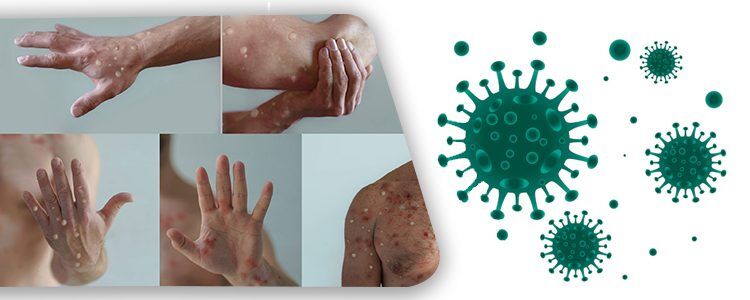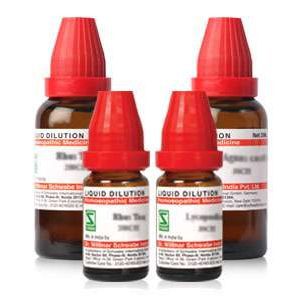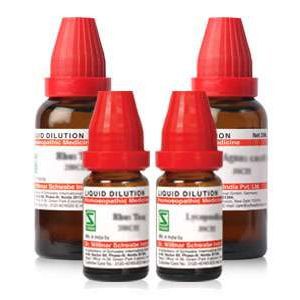
Monkeypox: How Is It Different From Other Viral Diseases?
- Dr. Aditi Sharma
- August 19, 2022
- No Comments

The recent emergence and multi-country outbreak of monkeypox are seen as a new public health care problem. The monkeypox outbreak is mainly attributed to the discontinuation of the smallpox vaccine in 1980 subsequent to its eradication. Due to the cessation of this smallpox vaccine a large chunk of the human population is now vulnerable to getting infected by the monkeypox virus.
It is said that if this virus which is at present mainly contained in adult men jumps to a large population of children or old people it can lead to grave consequences.
What Is Monkeypox? What Are The Causes Of Monkeypox?
Monkeypox is a viral zoonotic disease (transmitted from animals to humans). It is caused by the monkeypox virus belonging to the Orthopoxvirus genus of the Poxviridae family of viruses. According to CDC or Centers for Disease Control and Prevention, there are two kinds of monkeypox virus; Congo Basin and West Africa. The recent monkeypox outbreak is due to the West African type of monkeypox virus.
Although this infection is not much fatal however certain people have a greater risk of catching this infection, developing a severe form of the disease and even dying. This includes:-
- People with weak immunity
- People with a history of eczema
- Children under 8 years of age
- Pregnant females
- Breastfeeding females
Also Read Tomato Flu: Everything The Public Need To Know About The Virus
What Are The Causes Of Its Spread?
The rodents are considered to be the most likely natural reservoir of monkeypox.
Animal to human or zoonotic transmission of monkeypox is seen to occur in direct contact with the body fluids, blood or mucosal or cutaneous lesions of infected animals. Consuming inadequately cooked meat from infected animals is another possible risk factor. Residing in or close to forested areas may lead to low-level or indirect exposure to the monkeypox virus-infected animals.
Human-to-human spread is found to result from:-
- Contact with respiratory secretions of the infected person
- Contact with skin lesions of monkeypox-infected person
- Prolonged face-to-face contact with an infected person that leads to spreading through large droplet respiratory particles
- From infected mother to fetus via the placenta or on close contact during and after delivery
- Sexual transmission of monkeypox is as yet unclear.
What Are The Symptoms Of Monkeypox?

Monkeypox is a self-limiting viral disease. Its symptoms last from 2-4 weeks. The discontinuation of the smallpox vaccination after the disease got eradicated has made people younger than 40-50 years of age more prone to get monkeypox.
The incubation period or the interval from infection with the virus to onset of symptoms is generally from 6-13 days and can range from 5-21 days.
The symptoms of the West African strain of the Monkeypox virus are not life-threatening but they are very painful.
Monkeypox signs and symptoms during the invasion period that lasts between 0-5days are:-
- Fever
- Intense headache
- Swollen lymph nodes or lymphadenopathy. It is a characteristic feature of monkeypox as compared to other diseases such as measles, chickenpox and smallpox that may appear similar initially.
- Backpain
- Muscle pain or myalgia
- Intense lack of energy or asthenia
- Monkeypox rash or sores begins within 1-3 days from the onset of fever. The rash is found to be concentrated on the face in 95% of cases, on palms of hands and soles of feet in 75% of cases, oral mucous membranes in 70%cases, genitalia in 30%cases and conjunctiva and cornea in 20%cases. The rash in monkeypox develops sequentially from macules or lesions with a flat base to papules or lesions that are firm and slightly raised to vesicles or lesions filled with a clear fluid to pustules or lesions filled with yellowish fluid to crusts that become dry and fall off. The number of skin lesions may vary from a few to even several thousand in number. In severe monkeypox cases, the skin lesions merge until large areas of the skin fall off.
- In patients with lesions in the anorectal region additional symptoms such as rectal bleeding, anorectal pain or tenesmus can also be seen.
- The rashes or sores can cause permanent scar marks on the skin.
What Are The Complications Of Monkeypox In Humans?
The complications of monkeypox are:-
- Secondary infections
- Bronchopneumonia
- Sepsis
- Encephalitis
- Infection of the cornea resulting in loss of vision
How Widely Is Monkeypox Spread In India?
Across different parts of India, eight cases of monkeypox have been reported so far along with one death from this infection. According to the World Health Organisation (WHO) around 18,000 cases of monkeypox have been seen in 78 countries.
How Can You Protect Yourself From Monkeypox?

Do’s and Don’ts guidelines issued by the health department to protect from monkeypox are:-
Monkeypox: DO’s
- Keep the person infected with monkeypox isolated from others.
- Regularly wash hands with soap and water
- Use hand sanitiser
- When near an infected person one must wear gloves and wear a mask
- Use disinfectants to sanitize the home
- Health authorities have recommended the smallpox vaccine as a prophylactic to the close contact of monkeypox patients
Monkeypox: DON’Ts
- Don’t share towels, linen or bedding with a person who is infected with monkeypox
- Don’t wash the towels or linen of an infected patient with those of a healthy person
- Avoid going outside if one has symptoms of monkeypox.
Can Pets And Animals Get Monkeypox Infection?

According to CDC, despite being zoonotic disease monkeypox in animals has not shown any fatal or severe results as yet.
What Is The Treatment For Monkeypox?
Treatment for monkeypox is aimed to alleviate signs and symptoms, preventing long-term sequelae and managing complications if any. In addition, steps should be taken to keep the patient well hydrated by providing adequate fluids. Also, adequate food should be provided to the patient to maintain proper nutritional status.
As of now, according to the CDC, there is no specific treatment for monkeypox approved in the conventional system of medicine. Vaccine and antiviral compounds are still being assessed and developed to be used for the treatment of monkeypox.
Since there is no well-established treatment protocol with approved drugs, homeopathy provides a safe and effective option based on symptomatology. The best homeopathic medicine for the treatment of monkeypox is the one which is most similar to the unique pattern of presenting symptoms in each case of the disease. For this, a trained homeopathic physician may elicit symptoms from both the mental and physical spheres of the patient.
Also Read 13 Easy and Effective Monsoon Disease Prevention Tips
Common homeopathic medicines for monkeypox treatment
MERCURIUS SOLUBILIS– It is useful when there is an enlargement of the lymph glands, offensive sweat especially at night, excessive salivation with great thirst and frequent ulcers in the mouth and throat. The symptoms aggravate from exposure to a cold, damp environment, at night, from the warmth of the bed and during perspiration.
RHUS TOXICODENDRON– It is suitable to treat cases when the skin is red, swollen and itchy and has vesicles, herpes or erysipelas with burning and a tendency for scale formation as well as swelling of the glands. In fever, there may be strong muscular pain that increases from rest and becomes better from motion and external warmth.
MALANDRINUM-This medicine has been well known as a homeopathic prophylactic against smallpox. The skin is dry, scaly and itchy with rhagades on feet and hands that become worse in cold weather and on washing. There may be scabs on the upper lip which lead to stinging pain when peeled off. There may be bone-like protuberances on the skin. The toes tend to feel scalded and itch terribly.
VARIOLINUM– This remedy has been used in the prevention and treatment of smallpox-like symptoms. The skin is hot and dry with pustules. There is a high fever with intense radiating heat and profuse, bad-smelling sweat. There may be excruciating backache and pain in the legs with tired feelings and restlessness. The breathing is oppressed and there is a cough with viscid and bloody mucus.
-
 Dr Willmar Schwabe India Variolinum CHSale Product on sale
Dr Willmar Schwabe India Variolinum CHSale Product on sale₹105.00₹86.10 -
 Dr Willmar Schwabe India Rhus toxicodendron CHSale Product on sale
Dr Willmar Schwabe India Rhus toxicodendron CHSale Product on sale₹105.00₹86.10 -
 Dr Willmar Schwabe India Mercurius solubilis CHSale Product on sale
Dr Willmar Schwabe India Mercurius solubilis CHSale Product on sale₹105.00₹86.10Rated 5.00 out of 5 based on 1 customer rating
CONCLUSION
When the world is still grappling with the coronavirus as well as the menace of long Covid, the recent upsurge in monkeypox cases has emerged as a new challenge to deal with. It is a reminder that the best defence against infectious diseases is strong public health.
Monkeypox is a self-limiting zoonotic disease that is caused by two types of monkeypox viruses, i.e West African and Congo Basin.
The recent rise in monkeypox cases has been attributed to the West African type of monkeypox virus. The infection caused by this is usually not fatal but very painful.
Long-term face-to-face contact with the infected person is the most commonly seen method for transmission of this infection. The symptoms of monkeypox last from 2-4 weeks and include fever, myalgia, swelling of lymph nodes and skin eruptions that may be macular, papular, pustular or vesicular in nature. The vesicles develop crusts which then dry up and fall off.
For prevention, it is important to stay away from the infected person as well as his belongings, wash hands with soap and water frequently, use sanitizer regularly and wear gloves and masks when near a monkeypox-infected person.
Maintaining hydration and adequate rest is important along with the right treatment to prevent any complications or sequelae of the disease. Homeopathy provides a safe and effective option for the treatment of monkeypox.
































